Dynamics of Territorial Spatial Pattern and Landscape Impact under Different Economic Gradients: A Case Study of the Beijing-Tianjin-Hebei (BTH) Region, China
Abstract
:1. Introduction
2. Conceptual Framework
3. Materials and Methods
3.1. Study Area
3.2. Land Use/Land Cover Mapping
3.3. Construction of a Territorial Space Classification System
3.4. Methods
3.4.1. Area Changes of Territorial Space
3.4.2. Comprehensive Dynamic Index for Territorial Space
3.4.3. Territorial Type Transfer Matrix
3.4.4. Landscape Pattern Analysis
3.4.5. The Interaction between Territorial Spatial Change and Landscape Pattern
4. Results
4.1. Evolution of Territorial Space Area
4.2. Evolution of Territorial Spatial Change Intensity
4.3. Structural Transformation and Evolution of Territorial Space Types
4.4. Evolution of Landscape Pattern
4.5. The Relationship between Territorial Spatial Pattern Changes and Landscape Index
5. Discussion
5.1. Driving Factors and Regional Differences of Territorial Spatial Pattern Change
5.2. The Influence of Territorial Space Change on Landscape Pattern
5.3. Implications for the Optimal Management of Territorial Space
5.4. Limitation
6. Conclusions
Author Contributions
Funding
Data Availability Statement
Conflicts of Interest
References
- Yang, R.; Zhang, J.; Xu, Q.; Luo, X. Urban-rural spatial transformation process and influences from the perspective of land use: A case study of the Pearl River Delta Region. Habitat Int. 2020, 104, 102234. [Google Scholar] [CrossRef]
- UN-HABITAT. World Cities Report 2020: The Value of Sustainainable Urbanization; UN-HABITAT: Nairobi, Kenya, 2020. [Google Scholar]
- Abdullah, S.A.; Nakagoshi, N. Changes in landscape spatial pattern in the highly developing state of Selangor, peninsular Malaysia. Landsc. Urban Plan. 2006, 77, 263–275. [Google Scholar] [CrossRef]
- Chang, G.H.; Brada, J.C. The paradox of China’s growing under-urbanization. Econ. Syst. 2006, 30, 24–40. [Google Scholar] [CrossRef]
- Wu, Y.; Zhang, X.; Shen, L. The impact of urbanization policy on land use change: A scenario analysis. Cities 2011, 28, 147–159. [Google Scholar] [CrossRef]
- Huang, X.; Li, Y.; Yu, R.; Zhao, X. Reconsidering the Controversial Land Use Policy of “Linking the Decrease in Rural Construction Land with the Increase in Urban Construction Land”: A Local Government Perspective. China Rev. 2014, 14, 175–198. [Google Scholar]
- Wang, J.; He, T.; Lin, Y. Changes in ecological, agricultural, and urban land space in 1984–2012 in China: Land policies and regional social-economical drivers. Habitat Int. 2018, 71, 1–13. [Google Scholar] [CrossRef]
- Ning, J.; Liu, J.; Kuang, W.; Xu, X.; Zhang, S.; Yan, C.; Li, R.; Wu, S.; Hu, Y.; Du, G. Spatio-temporal patterns and characteristics of land-use change in China during 2010–2015. J. Geogr. Sci. 2018, 28, 547–562. [Google Scholar] [CrossRef] [Green Version]
- Wang, S.; Wang, S. Land use/land cover change and their effects on landscape patterns in the Yanqi Basin, Xinjiang (China). Environ. Monit. Assess. 2013, 185, 9729–9742. [Google Scholar] [CrossRef]
- Forman, R.T.T.; Godron, M. Landscape Ecology; Wiley: New York, NY, USA, 1986. [Google Scholar]
- Hubacek, K.; van den Bergh, J. Changing concepts of ‘land’ in economic theory: From single to multi-disciplinary approaches. Ecol. Econ. 2006, 56, 5–27. [Google Scholar] [CrossRef]
- Bai, L.M.; Xiu, C.L.; Feng, X.H.; Liu, D.Q. Influence of urbanization on regional habitat quality:a case study of Changchun City. Habitat Int. 2019, 93, 13. [Google Scholar] [CrossRef]
- Gu, Y. The Study of Hangzhou Spatial Structure and Evolution Law in 2000–2010; Zhejiang University: Hangzhou, China, 2016. [Google Scholar]
- Ewing, R.; Pendall, R.; Chen, D. Measuring Sprawl and Its Transportation Impacts. Transp. Res. Rec. 2003, 1831, 175–183. [Google Scholar] [CrossRef]
- Andersen, H.T.; Møller-Jensen, L.; Engelstoft, S. The End of Urbanization? Towards a New Urban Concept or Rethinking Urbanization. Eur. Plan. Stud. 2011, 19, 595–611. [Google Scholar] [CrossRef]
- Niu, M. Research on Evaluation and Optimization of Agricultural Spatial Pattern Based on Eco-Civilization in China; Chinese Academy of Agricultural Sciences: Beijing, China, 2016. [Google Scholar]
- Li, X.; Yeh, A.G.-O. Analyzing spatial restructuring of land use patterns in a fast growing region using remote sensing and GIS. Landsc. Urban Plan. 2004, 69, 335–354. [Google Scholar] [CrossRef]
- Dadashpoor, H.; Azizi, P.; Moghadasi, M. Land use change, urbanization, and change in landscape pattern in a metropolitan area. Sci. Total Environ. 2019, 655, 707–719. [Google Scholar] [CrossRef]
- Ahmad, S.; Avtar, R.; Sethi, M.; Surjan, A. Delhi’s land cover change in post transit era. Cities 2016, 50, 111–118. [Google Scholar] [CrossRef]
- Galacho Jiménez, F.B.; Reyes Corredera, S. The urban regulation of rural land from the perspective of the new Law for the Promotion of Territorial Sustainability in Andalusia (Andalusian Land Law). Bol. Asoc. Geógr. Esp. 2022, 94. [Google Scholar] [CrossRef]
- Zhou, P.; Huang, J.; Pontius, R.; Hong, H. Land Classification and Change Intensity Analysis in a Coastal Watershed of Southeast China. Sensors 2014, 14, 11640–11658. [Google Scholar] [CrossRef] [Green Version]
- Di, D.Y.; Wu, Z.N.; Wang, H.L.; Zhang, F.Y. Spatial pattern analysis on the functions of water resources economic–social–ecological complex system. J. Clean. Prod. 2022, 336, 130323. [Google Scholar] [CrossRef]
- Luo, Y.; Lü, Y.; Liua, L.; Liang, H.; Li, T.; Ren, Y. Spatiotemporal scale and integrative methods matter for quantifying the driving forces of land cover change. Sci. Total Environ. 2020, 739, 139622. [Google Scholar] [CrossRef]
- Chia-An, K. Incorporating spatial regression model into cellular automata for simulating land use change. Appl. Geogr. 2016, 69, 1–9. [Google Scholar] [CrossRef]
- Ralha, C.G.; Abreu, C.G.; Coelho, C.G.C.; Zaghetto, A.; Macchiavello, B.; Machado, R.B. A multi-agent model system for land-use change simulation. Environ. Model. Softw. 2013, 42, 30–46. [Google Scholar] [CrossRef]
- Su, S.; Jiang, Z.; Zhang, Q.; Zhang, Y. Transformation of agricultural landscapes under rapid urbanization: A threat to sustainability in Hang-Jia-Hu region, China. Appl. Geogr. 2011, 31, 439–449. [Google Scholar] [CrossRef]
- Wu, C. Man-Land Relationship and Economic Layout; Academic Press: Beijing, China, 1998. [Google Scholar]
- Wu, C. Comment on the core of the study of geography—The regional system of human and land relations. Econ. Geogr. 1991, 11, 1–6. (In Chinese) [Google Scholar]
- Wu, C. The theoretical research and regulation of the regional system of human–land relations. J. Yunnan Norm. Univ. (Philos. Soc. Sci.) 2008, 40, 1–3. (In Chinese) [Google Scholar]
- Ma, Y.L.; Xu, R.S. Remote sensing monitoring and driving force analysis of urban expansion in Guangzhou City, China. Habitat Int. 2010, 34, 228–235. [Google Scholar] [CrossRef]
- Wu, R.; Li, Z.; Wang, S. The varying driving forces of urban land expansion in China: Insights from a spatial-temporal analysis. Sci. Total Environ. 2021, 766, 142591. [Google Scholar] [CrossRef]
- Liu, J.; Zhang, Z.; Xu, X.; Kuang, W.; Zhou, W.; Zhang, S.; Li, R.; Yan, C.; Yu, D.; Wu, S.; et al. Spatial patterns and driving forces of land use change in China during the early 21st century. J. Geogr. Sci. 2010, 20, 483–494. [Google Scholar] [CrossRef]
- Verburg, P.H.; Steeg, J.V.D.; Veldkamp, A.; Willemen, L. From land cover change to land function dynamics: A major challenge to improve land characterization. J. Environ. Manag. 2009, 90, 1327–1335. [Google Scholar] [CrossRef]
- Angel, S.; Parent, J.; Civco, D.L. The dimensions of global urban expansion: Estimates and projections for all countries, 2000–2050. Prog. Plan. 2011, 75, 53–107. [Google Scholar] [CrossRef]
- Pan, W.; Wang, J.; Lu, Z.; Liu, Y.; Li, Y. High-quality development in China: Measurement system, spatial pattern, and improvement paths. Habitat Int. 2021, 118, 102458. [Google Scholar] [CrossRef]
- Outline of Coordinated Development of the Beijing-Tianjin-Hebei Region. Available online: http://www.bjchp.gov.cn/cpqzf/315734/tzgg27/1277896/ (accessed on 1 November 2021).
- Chenery, H.; Robinson, S.; Syrquin, M. Industrialization and Growth: A Comparative Study; Oxford University Press: London, UK, 1986. [Google Scholar]
- Xu, X.L.; Liu, J. A 5-year Spatial Distribution dataset of Terrestrial ecosystems in China (1990–2010). J. Glob. Chang. Data Discov. 2017, 1, 52–59. [Google Scholar]
- Sun, Z. Research Progress and Prospect of Spatial Planning at China and Abroad. Planners 2015, 31, 207–210. (In Chinese) [Google Scholar]
- Xu, Y. The Characteristics and Enlightenment of the Land Classification System in Japan. Urban Plan. Int. 2012, 27, 22–29. (In Chinese) [Google Scholar]
- Zhu, H.; Li, T. Japan’s Experience in Territorial Space Use Control and Its Enlightenments to China. Nat. Resour. Econ. China 2020, 33, 51–58. (In Chinese) [Google Scholar]
- Zhang, Y.; Ying, T.; Chen, H. Space Planning and Land Use Classifications in Foreign Countries and Their Enlightenments to China. Stand. Surv. Mapp. 2017, 33, 1–5. (In Chinese) [Google Scholar]
- Lin, Y.; Zhao, J.; Zhang, M.; Chen, G. Identification of Territory Space Pattern and Spatio-temporal Evolution Analysis of Urban Agglomeration in Central Yunnan. Trans. Chin. Soc. Agric. Mach. 2019, 50, 176–191. (In Chinese) [Google Scholar]
- The Several Opinions on Establishing Territorial Spatial Planning System and Supervising the Implementation. Available online: http://www.gov.cn/zhengce/2019-05/23/content_5394187.htm (accessed on 1 November 2021).
- Si, H. Spatial Regulation and Comprehensive Function Zoning of National Land Space in Qinghai Province; China University of Geosciences: Beijing, China, 2018. [Google Scholar]
- Li, G.; Fang, C. Quantitative function identification and analysis of urban ecological-production-living spaces. Acta Geogr. Sin. 2016, 71, 49–65. (In Chinese) [Google Scholar]
- Zhu, H.; Li, X. Discussion on the index method of regional land use change. Acta Geogr. Sin. 2003, 5, 643–650. (In Chinese) [Google Scholar]
- Pang, R.; Hu, N.; Zhou, J.; Sun, D.; Ye, H. Study on Eco-Environmental Effects of Land-Use Transitions and Their Influencing Factors in the Central and Southern Liaoning Urban Agglomeration: A Production–Living–Ecological Perspective. Land 2022, 11, 937. [Google Scholar] [CrossRef]
- Pickett, S.T.A.; Cadenasso, M.L. LANDSCAPE ECOLOGY—SPATIAL HETEROGENEITY IN ECOLOGICAL-SYSTEMS. Science 1995, 269, 331–334. [Google Scholar] [CrossRef]
- Wiens, J.A.; Milne, B.T. Scaling of ‘landscapes’ in landscape ecology, or, landscape ecology from a beetle’s perspective. Landsc. Ecol. 1989, 3, 87–96. [Google Scholar] [CrossRef]
- Wu, J.G.; Levin, S.A. A spatial patch dynamic modeling approach to pattern and process in an annual grassland. Ecol. Monogr. 1994, 64, 447–464. [Google Scholar] [CrossRef]
- Forman, R.T.T. Land Mosaics: The Ecology of Landscapes and Regions; Cambridge University Press: New York, NY, USA, 1995. [Google Scholar]
- Wu, J. Landscape Ecology—Pattern, Process, Scale and Hierarchy, 2nd ed.; Higher Education Press: Beijing, China, 2007. [Google Scholar]
- Su, S.; Wang, Y.; Luo, F.; Mai, G.; Pu, J. Peri-urban vegetated landscape pattern changes in relation to socioeconomic development. Ecol. Indic. 2014, 46, 477–486. [Google Scholar] [CrossRef]
- Tang, J.; Li, Y.; Cui, S.; Xu, L.; Ding, S.; Nie, W. Linking land-use change, landscape patterns, and ecosystem services in a coastal watershed of southeastern China. Glob. Ecol. Conserv. 2020, 23, e01177. [Google Scholar] [CrossRef]
- Li, H.; Peng, J.; Yanxu, L.; Yi’na, H. Urbanization impact on landscape patterns in Beijing City, China: A spatial heterogeneity perspective. Ecol. Indic. 2017, 82, 50–60. [Google Scholar] [CrossRef]
- Zhou, J.-H.; Zhu, Y.-M.; He, L.; Mu, B.-X. Recognizing and coordinating multidimensional dynamic stakeholder value conflicts for sustainability-oriented Construction Land Reduction projects in Shanghai, China: An integrated SA-SNA-TRIZ approach. J. Clean. Prod. 2022, 348, 131343. [Google Scholar] [CrossRef]
- Zhao, X.; Zhang, Z.; Wang, X.; Zuo, L.; Liu, B.; Yi, L.; Xu, J.; Wen, Q. Analysis of Chinese cultivated land′s spatio-temporal changes and causes in recent 30 years. Trans. Chin. Soc. Agric. Eng. 2014, 30, 1–11. (In Chinese) [Google Scholar]
- Jiang, Y.; Long, H.; Tang, Y.T.; Deng, W.; Zheng, Y. The impact of land consolidation on rural vitalization at village level: A case study of a chinese village. J. Rural Stud. 2021, 3, 485–496. [Google Scholar] [CrossRef]
- Long, H.; Li, T. The coupling characteristics and mechanism of farmland and rural housing land transition in China. J. Geogr. Sci. 2012, 22, 548–562. [Google Scholar] [CrossRef]
- Dong, J.; Liu, J.; Shi, W. China’s Sloping Land Conversion Program at the Beginning of 21st Century and Its Habitat Suitability in Typical Region of Loess Plateau. J. Resour. Ecol. 2010, 1, 36–44. [Google Scholar]
- Zhang, D.J.; Jia, Q.Q.; Xu, X.; Yao, S.B.; Chen, H.B.; Hou, X.H. Contribution of ecological policies to vegetation restoration: A case study from Wuqi County in Shaanxi Province, China. Land Use Policy 2018, 73, 400–411. [Google Scholar] [CrossRef]
- Liu, T.; Tian, X. The progress, Achievements and Prospects of the Collaborative Development in Beijing-Tianjin-Hebei Region. China Bus. Mark. 2019, 33, 116–128. (In Chinese) [Google Scholar]
- Wang, R. Efficient and Harmonious—Principles and Methods of Urban Regulation and Control; Hunan University: Changsha, China, 1988. [Google Scholar]
- Beijing Urban Master Planning (2004–2020). Available online: http://www.bjzx.gov.cn/zhuanti/20140321/01.html (accessed on 1 November 2021).
- Quan, B.; Pontius, R.G., Jr.; Song, H. Intensity Analysis to communicate land change during three time intervals in two regions of Quanzhou City, China. GISci. Remote Sens. 2020, 57, 21–36. [Google Scholar] [CrossRef]


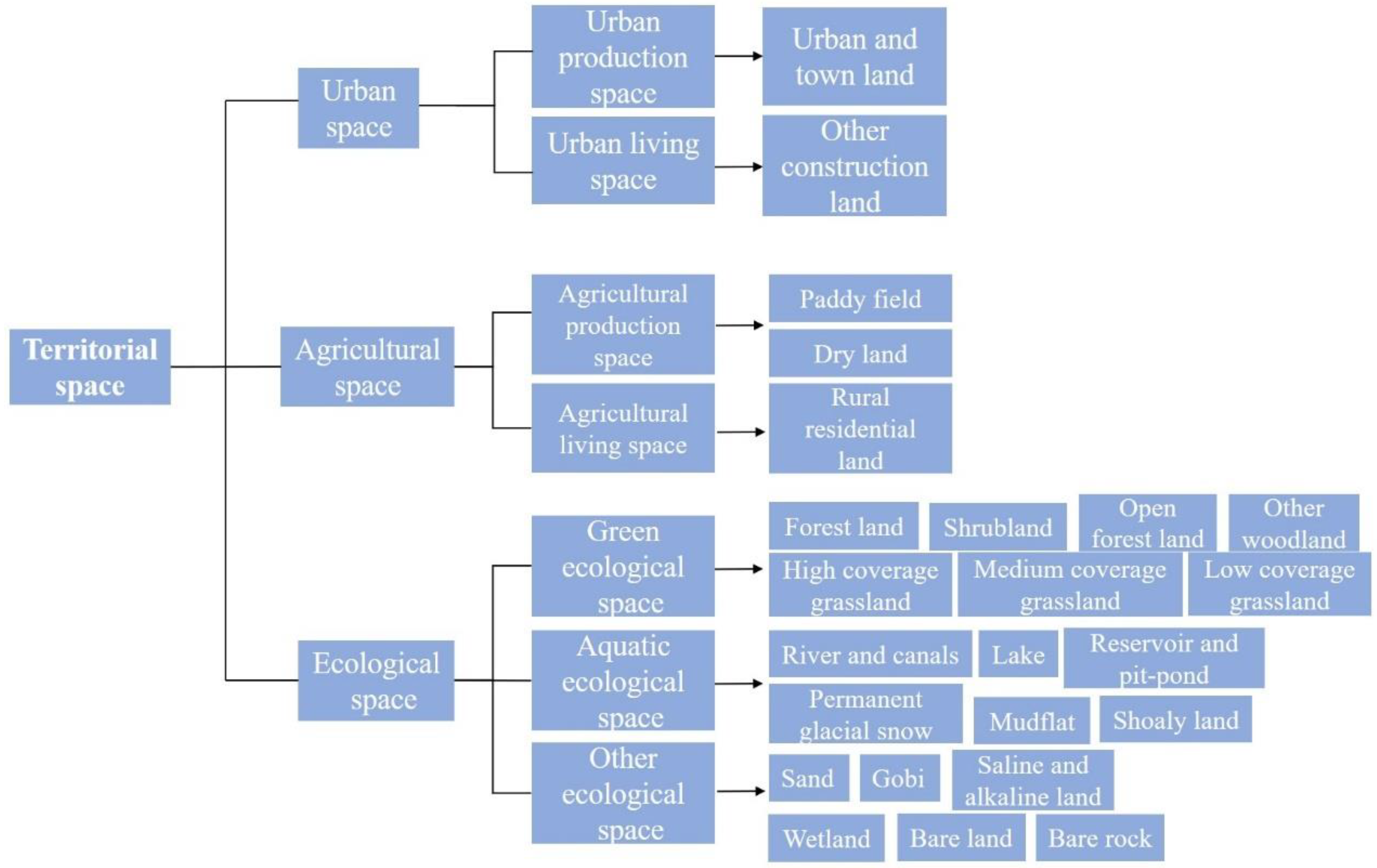

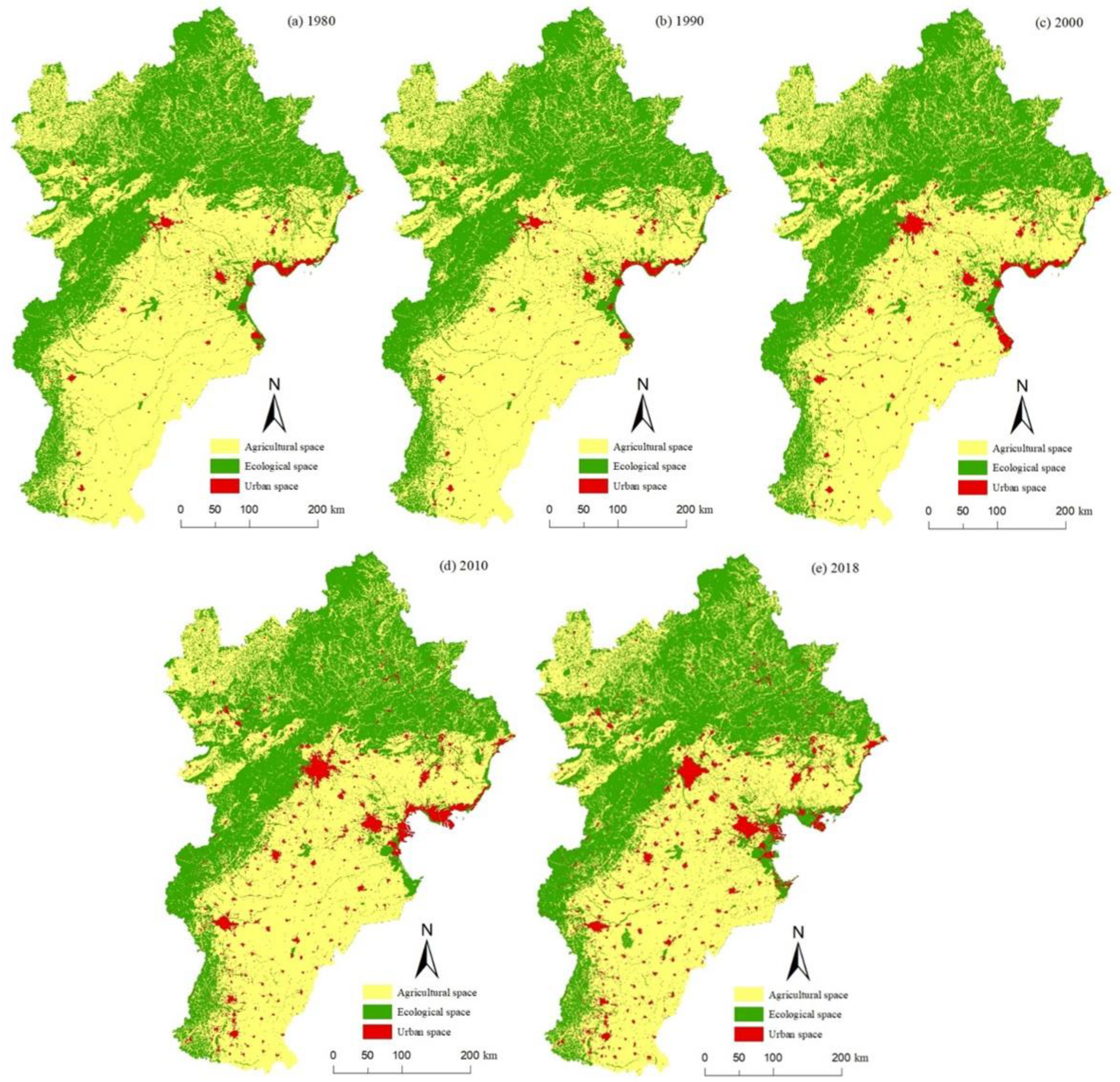
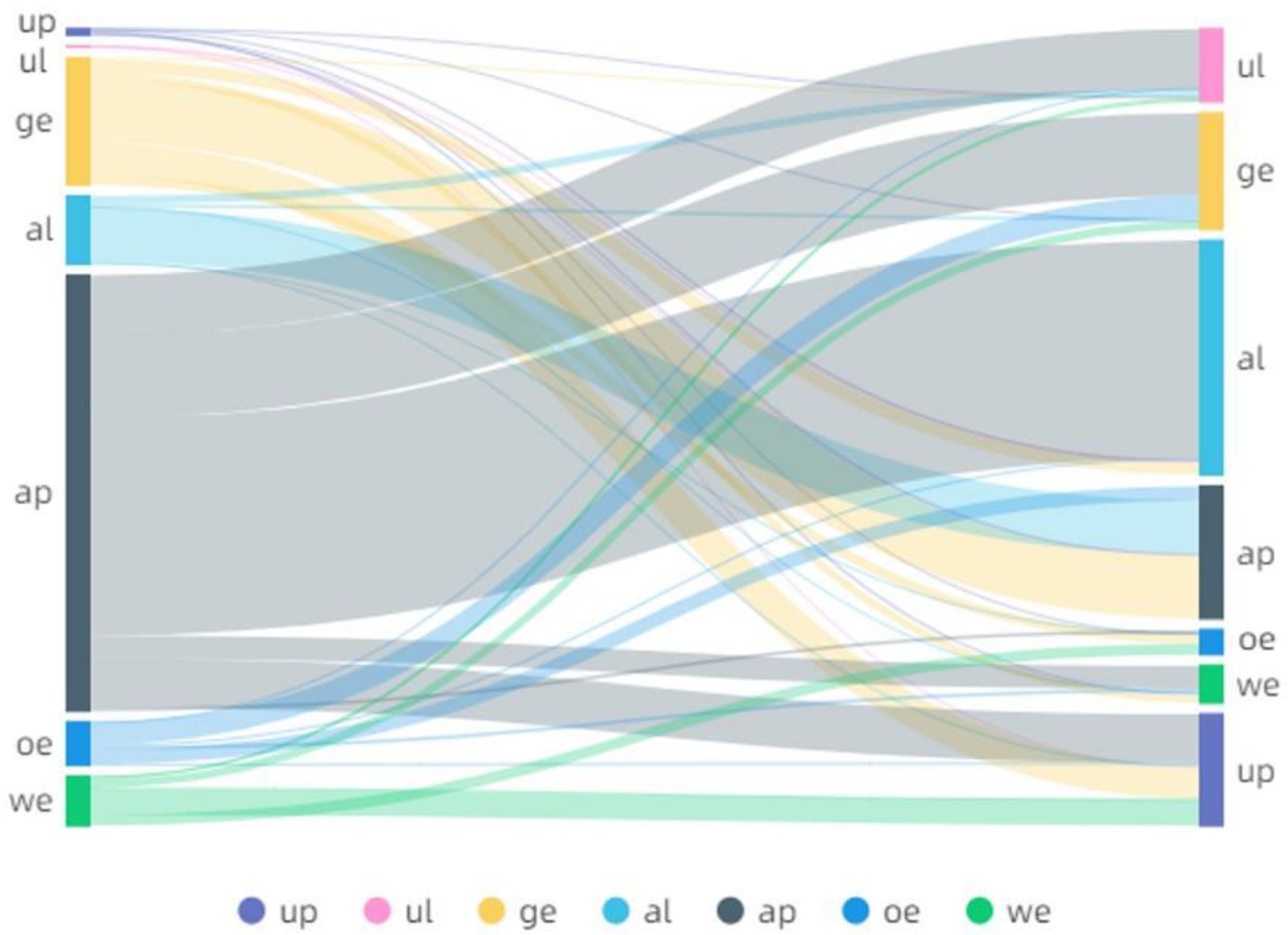

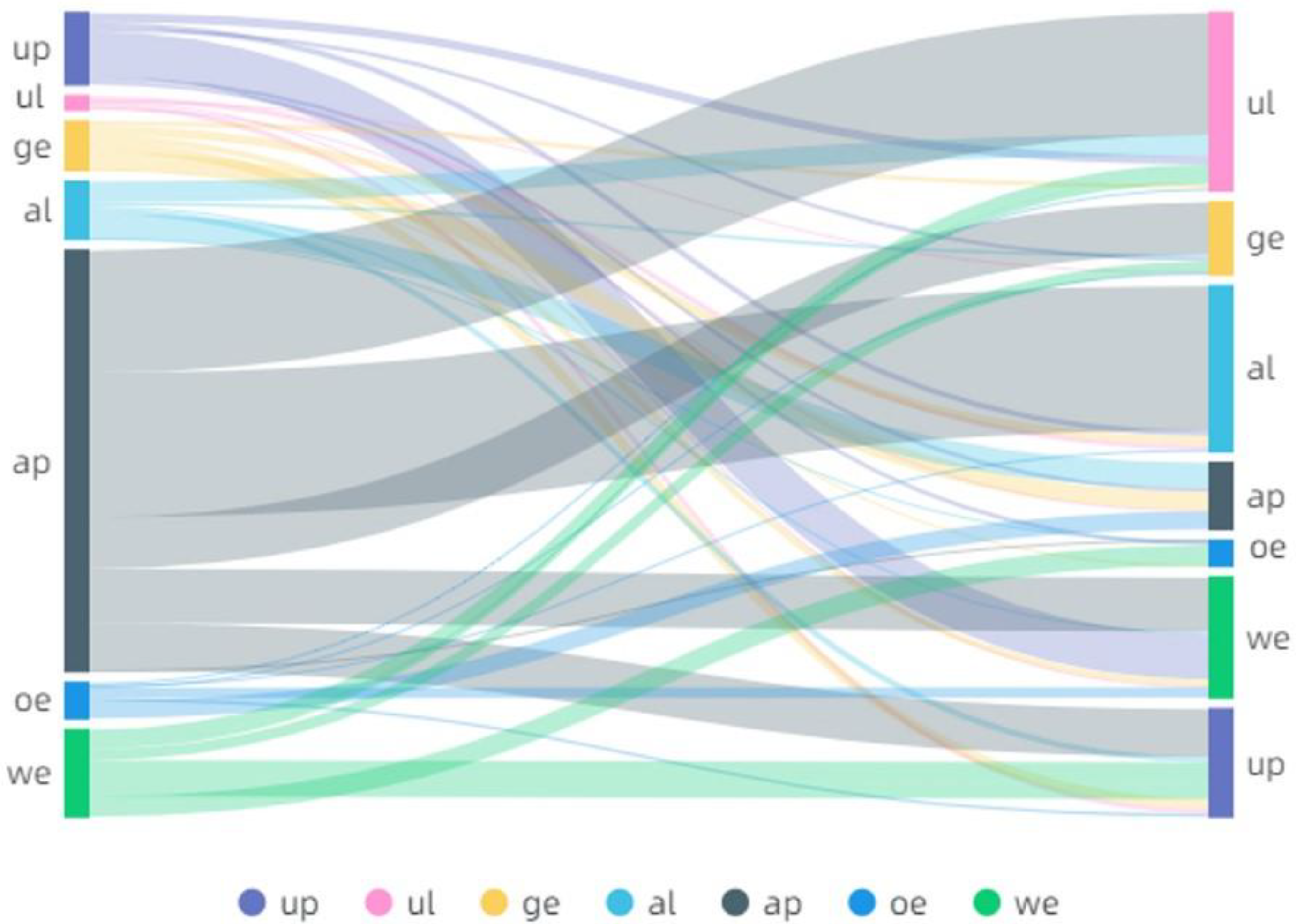
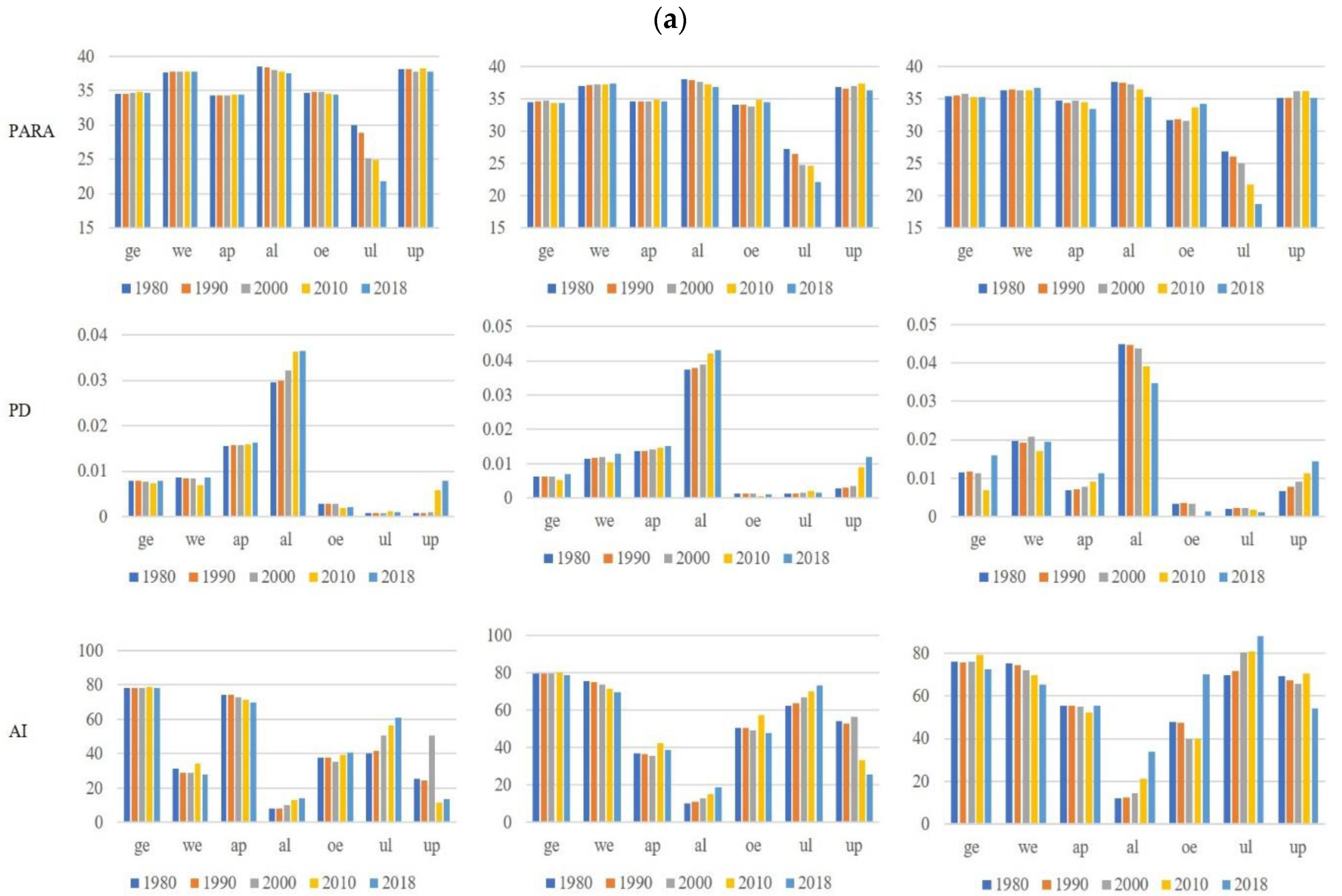

| The Landscape Index | Description | Calculation |
|---|---|---|
| PARA | The ratio of the perimeter to the area of a given patch, which is a simple measure of shape complexity | |
| PD | The number of patches per unit area of a certain type of the landscape elements, reflecting the degree of landscape fragmentation | |
| AI | Indicates the trend of spatial aggregation of patch types | |
| CONTAG | The degree of agglomeration or extension of different patch types in the landscape | |
| SHDI | A reflection of the richness and complexity of different landscape types |
| Low Development Level | Urban Space | Agricultural Space | Ecological Space | |||
| Area (km²) | Change rate | Area (km²) | Change rate | Area (km²) | Change rate | |
| 1980–1990 | 46 | 10.50% | 138 | 0.20% | −184 | −0.33% |
| 1990–2000 | 461 | 95.25% | −166 | −0.24% | −295 | −0.53% |
| 2000–2010 | 1249 | 132.17% | −473 | −0.68% | −776 | −1.39% |
| 2010–2018 | 703 | 32.04% | −1286 | −1.87% | 583 | 1.06% |
| Middle development level | Urban space | Agricultural space | Ecological space | |||
| Area (km²) | Change rate | Area (km²) | Change rate | Area (km²) | Change rate | |
| 1980–1990 | 171 | 10.72% | −35 | −0.08% | −59 | −0.21% |
| 1990–2000 | 840 | 47.57% | −787 | −1.87% | −127 | −0.46% |
| 2000–2010 | 1790 | 68.69% | −1197 | −2.90% | −481 | −1.76% |
| 2010–2018 | 554 | 12.60% | −922 | −2.30% | 404 | 1.51% |
| High development level | Urban space | Agricultural space | Ecological space | |||
| Area (km²) | Change rate | Area(km²) | Change rate | Area (km²) | Change rate | |
| 1980–1990 | 173 | 11.09% | −265 | −2.25% | 92 | 1.73% |
| 1990–2000 | 605 | 34.91% | −631 | −5.47% | 11 | 0.20% |
| 2000–2010 | 1779 | 76.09% | −559 | −5.13% | −861 | −15.84% |
| 2010–2018 | −522 | −12.68% | −653 | −6.32% | 1460 | 31.93% |
| Total | 7849 | — | −6836 | — | −233 | — |
| 1980–1990 | 1990–2000 | 2000–2010 | 2010–2018 | 1980–2018 | |
|---|---|---|---|---|---|
| Low development level | 0.55% | 2.82% | 14.94% | 6.44% | 18.99% |
| Medium development level | 1.69% | 5.48% | 21.77% | 14.57% | 31.29% |
| High development level | 4.96% | 12.36% | 33.32% | 49.29% | 73.69% |
| Low development level | PD | AI | CONTAG | SHDI |
| Urban space | 0.999 ** | −0.988 ** | −0.998 ** | 0.997 ** |
| Agricultural space | −0.934 * | 0.923 * | 0.929 * | −0.918 * |
| Ecological space | −0.735 | 0.729 | 0.741 | −0.759 |
| Medium development level | PD | AI | CONTAG | SHDI |
| Urban space | 0.957 ** | −0.968 ** | −0.856 | 0.994 ** |
| Agricultural space | −0.982 * | 0.991 * | 0.871 | −0.999 ** |
| Ecological space | −0.550 | 0.575 | 0.536 | −0.0.687 |
| High development level | PD | AI | CONTAG | SHDI |
| Urban space | −0.559 | −0.531 | −0.521 | 0.903 * |
| Agricultural space | 0.138 | 0.844 | 0.840 | −0.997 ** |
| Ecological space | 0.887 * | −0.693 | −0.701 | 0.200 |
Disclaimer/Publisher’s Note: The statements, opinions and data contained in all publications are solely those of the individual author(s) and contributor(s) and not of MDPI and/or the editor(s). MDPI and/or the editor(s) disclaim responsibility for any injury to people or property resulting from any ideas, methods, instructions or products referred to in the content. |
© 2022 by the authors. Licensee MDPI, Basel, Switzerland. This article is an open access article distributed under the terms and conditions of the Creative Commons Attribution (CC BY) license (https://creativecommons.org/licenses/by/4.0/).
Share and Cite
Lu, Z.; Zhang, Z. Dynamics of Territorial Spatial Pattern and Landscape Impact under Different Economic Gradients: A Case Study of the Beijing-Tianjin-Hebei (BTH) Region, China. Sustainability 2023, 15, 259. https://doi.org/10.3390/su15010259
Lu Z, Zhang Z. Dynamics of Territorial Spatial Pattern and Landscape Impact under Different Economic Gradients: A Case Study of the Beijing-Tianjin-Hebei (BTH) Region, China. Sustainability. 2023; 15(1):259. https://doi.org/10.3390/su15010259
Chicago/Turabian StyleLu, Zhaodi, and Zhengfeng Zhang. 2023. "Dynamics of Territorial Spatial Pattern and Landscape Impact under Different Economic Gradients: A Case Study of the Beijing-Tianjin-Hebei (BTH) Region, China" Sustainability 15, no. 1: 259. https://doi.org/10.3390/su15010259





